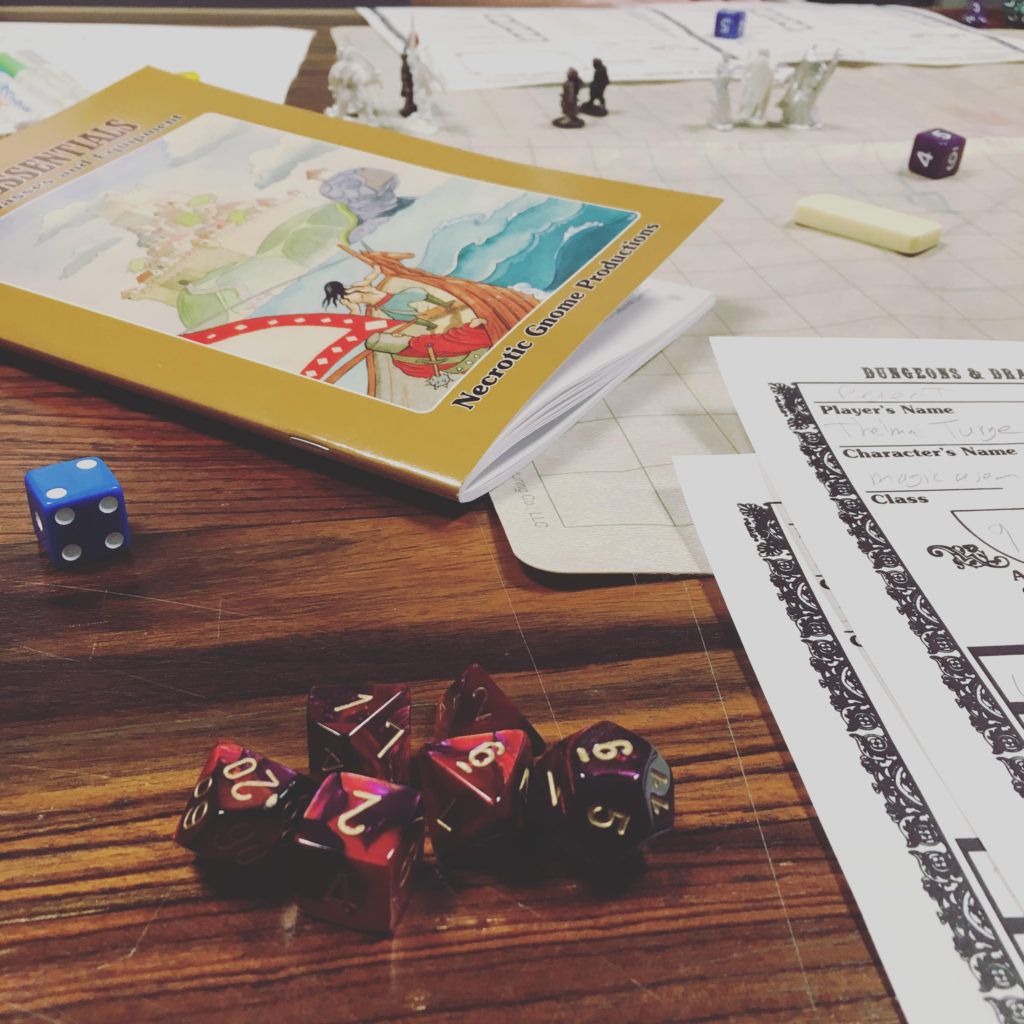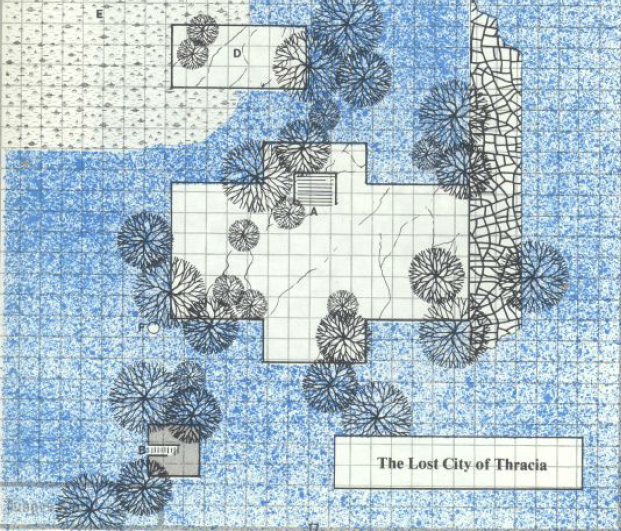Thursdays in Thracia Part 1
This is Part 1 of my Thursdays in Thracia B/X Dungeons & Dragons Campaign. For more context, check out Part 0.
[caption id=“attachment_335” align=“aligncenter” width=“525”] Photo by one of my players. One day I’ll get around to painting all the minis.[/caption]
Photo by one of my players. One day I’ll get around to painting all the minis.[/caption]
I ran the first session of The Caverns of Thracia last week, and it was, by and large, a success. I ended up with only three players, which would be a dangerously small number of PC’s in a B/X game, so I had each player create two characters. With a couple of hirelings in tow, a party of eight set out into the jungle in search of the famed lost city of Thracia, where vast riches and/or ignoble death await!
Here is a report of half of that session, followed by my relevant observations about B/X D&D so far.
What Happened
Because this campaign centers entirely on the dungeon, travel to and from “town,” as well as the rest of the outside world, is totally abstract. The Caverns of Thracia doesn’t specify from which direction the players approach the dungeon, so I just rolled a die. South!
Approaching the south side of the crumbling ruins, the party spied a ten foot high stone platform, just visible in the dense foliage ahead. They did what parties of courageous tomb robbers have been doing since 1974, and coaxed a hapless retainer ahead to “check it out.” Judith Straitjacket passed her morale check and agreed.
According to the module, there was a 60% chance that a group of Gnolls were stationed on the platform, and there they were. I decided the best way to handle this offscreen was to simply make a reaction roll for the Gnolls, to judge their attitude towards Judith. The result was “Indifferent, Uninterested,” so I decided they didn’t notice Judith, who went back and reported her findings to the party.
The party approached the four Gnolls. Thelma Turge, first level Magic-User, downed them all with a sleep spell in the first round of combat. The party slit the throats of three of the now helpless monsters. They awoke the fourth, and Yam Stevens, another Magic-User, used Charm person on him. Yam named the gnoll Slam, being unable to pronounce his Gnollish name, although the two could converse in the language of Chaos.
Slam told the party about a nearby entrance to the underground tunnels, to an area controlled by a tribe of “Filthy Humans.” The party instructed Slam to blame the violence on the tribesmen, then decided to head back to town for now, because they were already out of spells.
[caption id=“attachment_336” align=“alignnone” width=“621”] The Lost City of Thracia, Judges Guild 1979[/caption]
The Lost City of Thracia, Judges Guild 1979[/caption]
When they returned two days later, the still-charmed Slam was waiting by the tribesmen’s entrance with two other Gnolls. Apparently they had chased off the tribal guards.
The party charged forward, engaging at a distance and killing one of the Gnolls. The other, wounded, fled into the darkness. Slam stood there, confused as to why his friends were killing each other. The party tried to coax Slam down into the darkness ahead of them, but he failed a morale roll and refused to enter Tribesman territory, so the party descended without him.
On the long stairway down, they ran into and slew the wounded Gnoll. The party pressed downward into the waiting darkness…
Playing B/X
Cloudy With a Chance of Gnolls
During these early moments, it struck me how much this era of Dungeons & Dragons is reliant on the particular module you are running. On some level, the dungeon is the game. The core rules give you a baseline to work from, but the module you are working with is really going to guide a lot of the experience. The Caverns of Thracia in particular is crammed with events and encounters that may or may not happen based on positioning and chance. For example, if that 60% chance of Gnolls had gone the other way, the party would likely have walked right up to another entrance to the dungeon, completely unguarded, and entered that way. Instead, they are already messing with two of the dungeon’s factions, and have entered the dungeon through a less obvious, potentially more dangerous route. I don’t know that this says much about B/X or just about Jaquays’ brilliant adventure design.
Hell No, He Won’t Go
In B/X, a morale check is made by rolling 2d6 and comparing it to an NPC’s Morale score. If the roll is higher, the NPC flees from the current danger, or refuses to go on. Both monsters and retainers are subject to these rules, with a retainer’s Morale based on the hiring character’s Charisma.
I’ve made use of the morale rules outside of combat twice already. I am finding them incredibly useful as a way to disclaim responsibility for an NPC’s actions. Modern games like fifth edition are likely to make this something player facing, where a PC can use a skill to convince or intimidate an NPC into doing something. That kind of resolution always feels like a weird version of mind control to me, and invites the kind of play where every PC will try rolling everything to get a character to do what they want. There are certain things that people will not do, no matter how hard someone tries to convince them.
A morale check puts this outside anyone’s direct control. I really like that as a DM. When Slam failed his check to descend alone into the dungeon, the players wanted to keep trying to talk him into it, but the roll gave me grounds to say “no, he failed, he absolutely will not do this” without being arbitrary or resorting to fiat. Like the percentage check for Gnolls above, if the moment had gone the other way, it would have likely affected the rest of the session. Slam would have encountered the wounded Gnoll down there. I wonder what would have happened?
Uncertainty is Fun
In a lot of ways, the B/X rules are much, much lighter than the 5e rules, but they exist in different places. In 5e, the majority of the rules are loaded onto the player characters as abilities. This gives the players a greater sense of agency over the world on a moment to moment basis. In B/X, things like random encounters and morale checks exist as part of the world, not really tied to any particular character. The rules step in at these particular moments to push the potential game in one direction or another, totally outside of any player’s control, including my own. I’m interested in seeing how these moments compound on each other as the game continues.
More of this session coming next week!
In the meantime, I’ve gotten a couple of requests for an email sign-up option. I’ve added a signup form over in the sidebar to the right. If you want to get an email when I post, pop your address in there. Thanks!